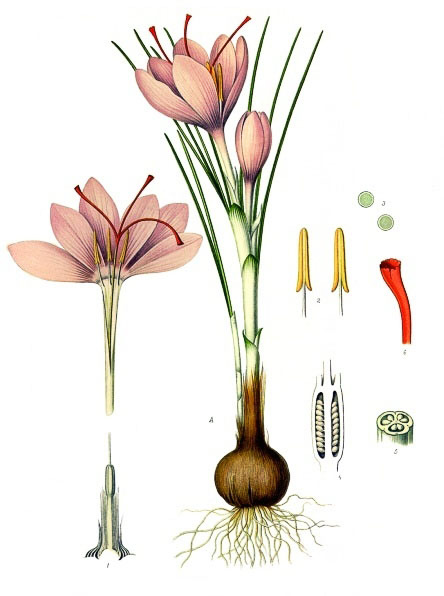Saffron
Saffron was considered a luxury even in ancient times, and the Phoenicians used it both as a spice and for medicinal purposes. Counterfeiting and adulterating it were punished severely.
FOLKLORE:
Saffron derives from the Persian word za'ferân.
Saffron is taken from the flower of the saffron crocus, a bulbous plant.
APPEARANCE:
The flower of the saffron crocus consists of six lilac to bright violet petals. Only certain varieties such as the Crocus sativus bear the red to purple stigmas, which are also called threads, and stimmi in Italian. These tiny threads are used as the spice. The plant, which blooms from September to October, grows up to 15 centimetres in height. Its narrow, linear leaves are dark green.
HABITAT:
Saffron flourishes in nutrient-poor, almost sandy soil on steep ground with a good deal of sunlight or moderate shade. For this reason it can survive frost and temperatures to minus 20 degrees Celsius.
RANGE:
The plant originated on Crete as the Crocus cartwrightianus. Currently, it can be found in the Mediterranean region, southern Europe, Asia Minor, India, Pakistan and China. The best saffron comes from Spain (Coupé and La Mancha).
USE FOR ABORTION:
Saffron is mentioned in the Corpus Hippocraticum (ca. 400 BC) as an abortifacient. It was also used for amenorrhoea, the absence of a menstrual period, and lochia, post-partum vaginal discharge.
HISTORY:
In the place of its origin, Crete, saffron already played a significant role during the Bronze Age, as is shown by the famous frescoes at Knossos and on Santorini (see Notes). Zeus is said to have slept on a bed of saffron, and the Phoenicians used it both as a spice and for medicinal purposes.
Saffron was considered a luxury even in ancient times. In Rome, it was used to dye the edges of togas, the clothing worn by magistrates. Counterfeiting and adulterating it were punished severely. Even today, saffron is the most expensive spice in the world (one gram costs approximately €6.00).
The plant is mentioned in the Ebers Papyrus (ca. 1600 BC) and the Bible, in the Psalms of Solomon.
Dioscurides recommended saffron as a diuretic, for discharge from the eye and gynaecological problems. At the same time, he also warned that it could be poisonous.
INGREDIENTS:
Crocin, crocetin, picrocrocin, safranal, riboflavin, essential oil.
EFFECTS:
Aphrodisiac, promotes menstruation, abortive, relatively high dosages (more than 1.5 grams) can result in symptoms of poisoning such as vomiting, intestinal cramping, bleeding of the uterus or mucous membranes, a dazed feeling, dizziness, yellow colouration of the skin and mucous membranes, and central nervous system paralysis.
APPLICATIONS:
As a spice and dye; for melancholy, hypochondriac and hysterical complaints, asthma, cough and stomach cramps. At present, it is used solely in cooking as a colouring agent with a slightly bitter flavour, e.g. in curried rice, risotto and paella.
Notes:
Wealthy Romans covered their beds with saffron on their wedding nights, possibly giving rise to the Latin expression dormivit in sacco croci (he has slept in a bed of saffron), which refers to the enlivening effect ascribed to it. In any case, saffron is used to dye wedding veils yellow in a number of cultures. Minoan frescoes might explain the origin of the relationship between gynaecology, dyeing and wedding rituals.
http://de.wikipedia.org/wiki/Bild:Saffron_gatherersSantorini-3.jpg http://de.wikipedia.org/wiki/Bild:Saffron_gatherers_detail_Thera_Santorini.gif
And a widely known children’s song in German which is similar to ‘Pat-a-cake, pat-a-cake, baker’s man’ refers to how
Saffron makes the cake yellow

